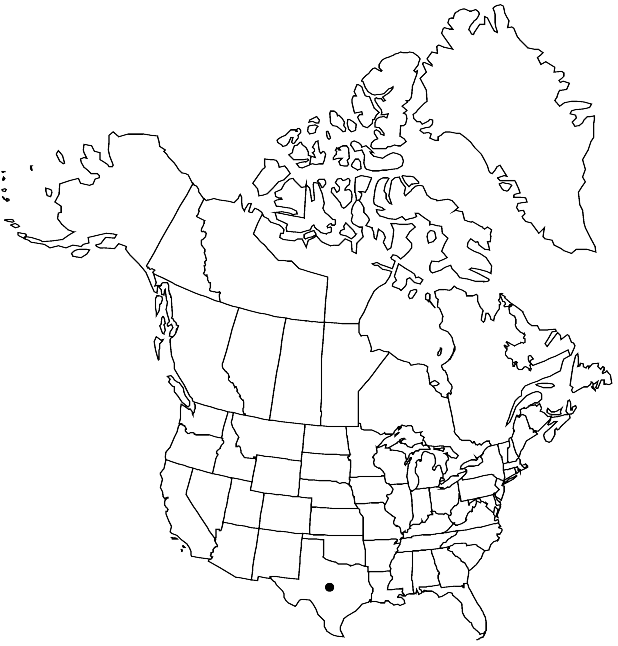Difference between revisions of "Physaria argyraea subsp. argyraea"
FNA>Volume Importer |
imported>Volume Importer |
||
| (6 intermediate revisions by 2 users not shown) | |||
| Line 1: | Line 1: | ||
{{Treatment/ID | {{Treatment/ID | ||
|accepted_name=Physaria argyraea subsp. argyraea | |accepted_name=Physaria argyraea subsp. argyraea | ||
| − | |accepted_authority= | + | |accepted_authority= |
|publications= | |publications= | ||
|basionyms= | |basionyms= | ||
| Line 19: | Line 19: | ||
|elevation=0-800 m | |elevation=0-800 m | ||
|distribution=Tex.;n Mexico (Coahuila;Nuevo León). | |distribution=Tex.;n Mexico (Coahuila;Nuevo León). | ||
| − | |discussion=<p>Subspecies argyraea differs from subsp. diffusa (Rollins) O’Kane & Al-Shehbaz of the Sierra Madre Oriental of Mexico in being herbaceous (rather than at least somewhat woody throughout) and having decumbent to erect (rather than prostrate) stems.</p> | + | |discussion=<p>Subspecies argyraea differs from <i></i>subsp.<i> diffusa</i> (Rollins) O’Kane & Al-Shehbaz of the Sierra Madre Oriental of Mexico in being herbaceous (rather than at least somewhat woody throughout) and having decumbent to erect (rather than prostrate) stems.</p> |
|tables= | |tables= | ||
|references= | |references= | ||
| Line 28: | Line 28: | ||
-->{{#Taxon: | -->{{#Taxon: | ||
name=Physaria argyraea subsp. argyraea | name=Physaria argyraea subsp. argyraea | ||
| − | + | |authority= | |
| − | |authority= | ||
|rank=subspecies | |rank=subspecies | ||
|parent rank=species | |parent rank=species | ||
| Line 43: | Line 42: | ||
|publication year= | |publication year= | ||
|special status= | |special status= | ||
| − | |source xml=https:// | + | |source xml=https://bitbucket.org/aafc-mbb/fna-data-curation/src/2e0870ddd59836b60bcf96646a41e87ea5a5943a/coarse_grained_fna_xml/V7/V7_1021.xml |
|tribe=Brassicaceae tribe Physarieae | |tribe=Brassicaceae tribe Physarieae | ||
|genus=Physaria | |genus=Physaria | ||
Latest revision as of 22:29, 5 November 2020
Perennials; caudex simple or branched, (woody); ± densely pubescent, trichomes (sessile or short-stalked), few- to several-rayed, rays fused at base, (smooth or finely tuberculate). Stems simple or several from base, prostrate and spreading to decumbent or erect, 0.5–4(–7) dm. Basal leaves (usually shed early); blade oblanceolate, 2–6(–8) cm, margins entire or pinnatifid. Cauline leaves (densely overlapping, often appressed, erect; petiolate); blade elliptic or obovate to rhombic, 0.5–4.5 cm, margins entire or sinuate or remotely dentate, (apex usually acute). Racemes loose. Fruiting pedicels (spreading to erect or occasionally slightly recurved, sigmoid, straight, or slightly curved), 15–40 mm. Flowers: sepals linear to oblong or elliptic, (3–)4–8 mm, (median pair thickened apically, cucullate); petals (orange or yellow, rarely fading purplish, claw often orange), spatulate or obovate to obdeltate, (narrowing to relatively short claw), 4.5–8.5(–11) mm. Fruits subglobose to broadly ellipsoid, slightly compressed (or terete), 4–8 mm; valves (not retaining seeds after dehiscence), glabrous throughout; replum as wide as or wider than fruit; ovules 16–32 per ovary; style 1.5–5.5 mm. Seeds flattened, (sometimes narrowly margined).
Phenology: Flowering Feb–May(-Jun).
Habitat: Sandy granite- or, usually, limestone-derived soils
Elevation: 0-800 m
Distribution

Tex., n Mexico (Coahuila, Nuevo León).
Discussion
Subspecies argyraea differs from subsp. diffusa (Rollins) O’Kane & Al-Shehbaz of the Sierra Madre Oriental of Mexico in being herbaceous (rather than at least somewhat woody throughout) and having decumbent to erect (rather than prostrate) stems.
Selected References
None.